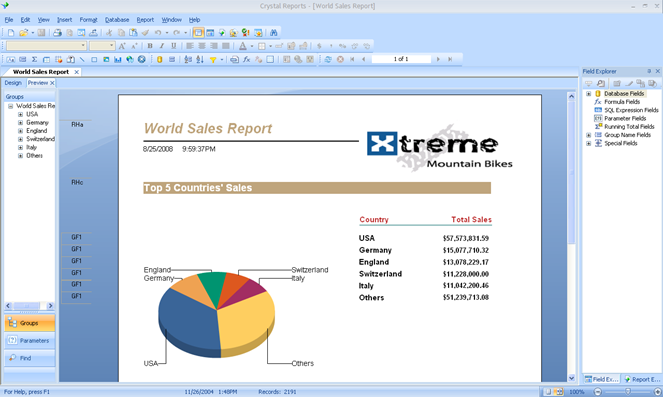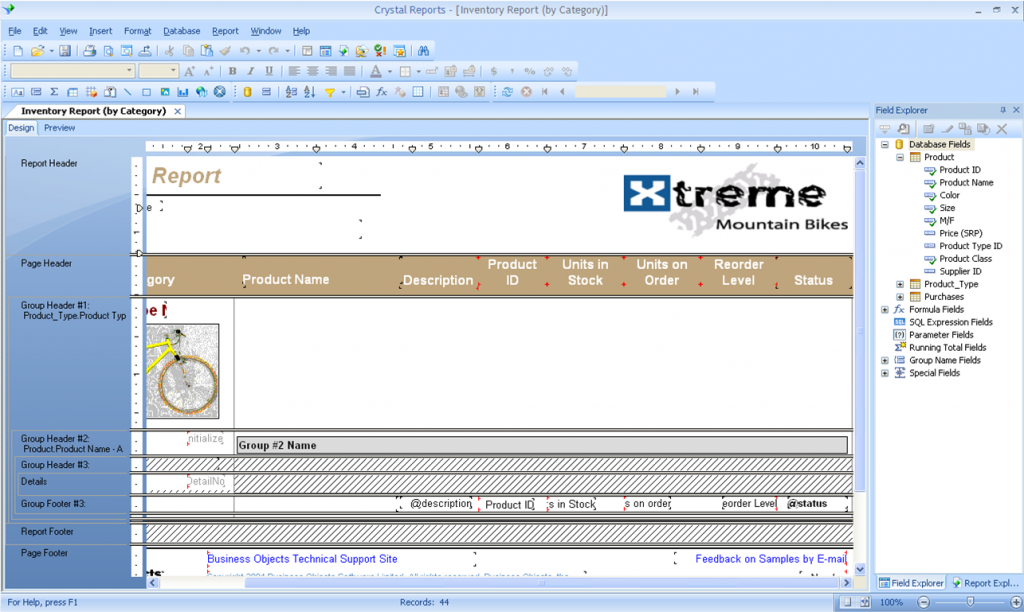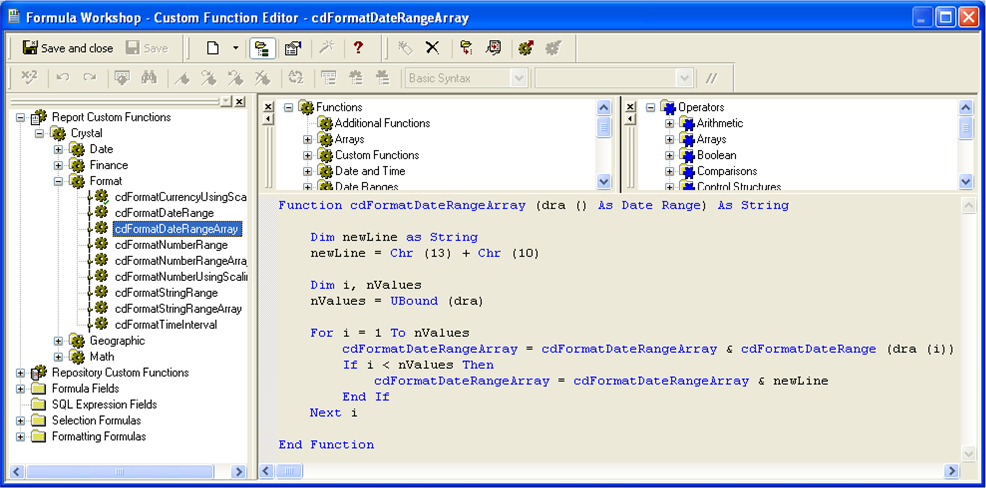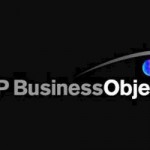
Crystal Reports is an operational reporting system that enables report authors to easily design interactive reports and connect them to virtually any data source. It is the ideal solution for canned or published reports as it allows for the creation of high-fidelity, pixel-perfect reports. Additionally, end-users benefit from numerous advanced viewing and interaction features – giving them the power to make insightful and well-informed decisions.
The product was originally created by Crystal Services Inc. as Quik Reports when the company couldn’t find a suitable commercial report writer for their accounting software. After producing versions 1.0 through 3.0, the company was acquired in 1994 by Seagate Technology. Crystal Services was then combined with Holistic Systems to form the Information Management Group of Seagate Software, which was later re-branded as Crystal Decisions. Subsequently versions 4.0 through 9.0 were produced. Crystal Decisions was then acquired in December 2003 by Business Objects, which has so far produced versions 10, 11 (XI) and the current version 12 (2008). Business Objects was then acquired by SAP in October 2007.
With Crystal Reports, report authors and end-users can leverage an intuitive interface, access data spread across multiple sources, design reports with guided interactivity, and integrate reports within both client-server and web applications.
Crystal Reports: Powerful and Highly-Intuitive Reports
Crystal Reports offers a high degree of flexibility and control over how data is presented and formatted. Additionally, Crystal Reports allows for raw data to be transformed into highly formatted, professional-looking reports with a superb presentation quality.
* Any Report Type: Virtually any report type can be developed including cross-tab, conditional, top N/bottom N, summary/drill-down, form, mailing label, OLAP, and subreport.
* Charting and Mapping: The graphical impact of your reports can be enhanced by choosing from a wide variety of map and chart types including bar/3D bar, pie/doughnut, line, Gantt, gauge, funnel, XY scatter, ranged map, dot density map, and more.
* Customizable Report Viewers: Available are a variety of server-side and thin-client report viewer controls, including DHTML page (WebForms) viewer, .NET WinForms viewer, Java viewer, ActiveX, and Report Part viewer (mobile viewer), that render reports into various output formats without additional coding. End user report interactivity options—including page forward/back, drill up/down, export, and print—are automatically included and can be easily customized.
Crystal Reports: Advanced Report Design Environment
Report developers benefit from a complete set of layout and design controls to create highly formatted, interactive, and professional looking reports. This powerful report development environment includes …
* Visual Report Designer: An intuitive, drag-and-drop interface and object-oriented explorer that allows for rapid development of reports.
* Experts and Wizards: Highly-intuitive tools and commands that automate common reporting tasks such as connecting to a data source, selecting, grouping, sorting, and summarizing data.
* Grouping Data: Bundles like data with customizable breaks and into group sections. The sections can then manipulated independently of the data by defining colors, spacing, page-breaking and other options to showcase the raw data and produce a more professional-looking report.
* Reusable Report Objects: Expedites the report design process by storing key report objects—including text objects, SQL commands, bitmaps, and custom functions (formulas)—in a central managed library (provided in Crystal Enterprise) for sharing, reuse, and single-point updating across multiple reports.
* Customizable Templates: Specifies and controls formatting and logic standards—including data access operations—to ensure design consistency across reports.
* Asymmetric Reporting: Provides a customized view of OLAP grids.
* MS Access and MS Excel Add-ins: Intuitive wizards and tools that allow report authors to easily design a Crystal Report right within Microsoft Access or Excel.
Crystal Reports: Data Access To Most Common Data Sources
Crystal Reports provides broad data connectivity options to access almost any enterprise data sources including…
* Relational databases (Oracle, IBM DB2, Sybase, MS SQL Server, MS Access, MySQL, and Informix.)
* Common Business Applications (ACT!, Salesforce.com)
* Spreadsheets (MS Excel, Lotus 1-2-3)
* Groupware / Email
* Business Objects Universes and Repositories
* Text files, XML files, and OS Event Logs
* Application systems (CRM, ERP, etc.)
* ODBC, OLE DB, and JDBC sources
* Web Services
In addition developers can write their own SQL commands or use the Crystal Reports proven query generation capabilities for flexible control over database connectivity.
Crystal Reports: Numerous Methods for Report Viewing and User-Interaction
Crystal Reports provides flexible options that let end-users view and interact with information in familiar formats with methods and controls that are easily understood.
* Multiple Export Formats: Provides end users with reports in the format they prefer and allows reports to export to popular formats, including Excel, PDF, XML, HTML, RTF, and more.
* Parameters: Lets users view the same data in different ways without creating multiple reports. End users can select predefined parameters in a single report to receive a subset of customized data.
* Alerting: Highlights specific information for end users with report alerts—user-defined messages that appear when certain conditions are met by the data in a report.
* Guided Navigation: Defines specific navigation paths between report objects within the same or different reports for easier end user navigation.
* Sorting Controls: Allows users to sort data fields and columns in either ascending or descending order.
* Hyperlinks: Converts reports into interactive web documents that connect to related information, including web sites and other reports.
* Drill-Down: Without formulas or programmatic coding, reports can be setup to allow end-users to drill down on relational and OLAP data to uncover details that might otherwise go unnoticed.
* Report Parts: Allows existing reports for use with wireless devices and corporate portals. Provides end users with access to charts, summary tables, specific records, and other key report information via portals, WML phones, RIM Blackberry, and Compaq iPAQ devices.
Crystal Reports: Sophisticated Formula Editor
Crystal Reports comes with a powerful set of tools that let report authors build sophisticated formulas within a report. Utilizing program code, report authors can perform tasks such as conditional formatting, specialized calculations, selecting records and report alerts. Additionally, formulas can be written in either Crystal or Basic syntax (very similar to Visual Basic).
* Powerful Formula Language: Extensive coding language that can control many advance features of the report. Includes over 240 built-in and user-defined functions and operators that can tightly control report formatting, complex logic, and data selection.
* Custom Functions: Create and store programmatic functions and calculations to share with other report authors. Eliminates redundant formula creation and allows code to be utilized across multiple reports.
* Formula Expert: Wizard that creates Crystal code based on an existing functions or manually developed code.
Crystal Reports: Integration of Reporting with Applications and Portals
Crystal Reports supports both Java and .NET platforms and provides a wide-range of proven Java, .NET, and COM components that help reduce the complexity of developing and integrating reporting functionality into portals, web, windows, client-server, web services, and/or mobile applications.
* Interface Solution Deployment Kits (SDKs): The Crystal Reports comprehensive interface SDKs are designed for J2EE, .NET, and COM applications and provide flexible control over how end users interact with reports. These SDKs include a variety of report viewing, creation, and modification APIs that allow for the implementation of a range of interactivity capabilities—from static report processing/viewing to complex run-time report creation/modification.
* Reporting Components: Crystal Reports Java, .NET, and COM reporting components can be embedded directly into custom applications.
* Custom Tag Library: Utilizing custom JSP tags, develops can add a customized viewer to web applications and reduce the amount of coding required to embed report templates into JSP web pages.
* Customizable Report Viewers: A variety of server-side and thin-client report viewer controls exist, including a Java viewer, DHTML (WebForms) Viewer, WinForms Viewer, ActiveX, and Report Part Viewer (mobile viewer) that render reports into various output formats without additional coding. End user report interactivity options—including page forward/back, drill up/down, export, and print are automatically included.
* IDE Integration: Allows report integration to be developed within a common integrated development environment (IDE) including Microsoft Visual Studio .NET, BEA WebLogic Workshop, Borland JBuilder, and Borland C# Builder.
* Royalty-Free Runtime: Allows for hundreds of royalty-free run-time properties, methods, and events to be integrated into thick-client applications for deployment at no additional cost.









